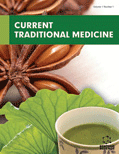Abstract
Background: The rapid global spread of the COVID-19 pandemic urged scientists to search for effective and safe anti-coronavirus drugs from natural resources. Through centuries, traditional medicinal plants have been providing cure for diseases and general health care worldwide.
Objective: The main aim of this review was to explore and summarize the research works on the different plants used traditionally in Sudan to treat signs and symptoms of COVID-19 and respiratory diseases, characterizing their antiviral activities and exploring the different phytochemicals present in these plants.
Methods: The current review was carried out in line with the recommendations of the PRISMA 2020 statement. Information on plants traditionally used in Sudan to treat the signs and symptoms of COVID-19 and respiratory diseases was obtained from traditional medicine books and published articles, as well as the daily practice by ordinary people.
Results: This article illustrated the use of 27 plant species belonging to 15 families in Sudanese traditional medicine to treat signs and symptoms of COVID-19 and respiratory diseases. Leguminosae/ Fabaceae was found to be the most represented family (7 species), followed by Combretaceae (3 species) and Capparidaceae and Malvaceae (2 species each). From these plants, about 11 plant species were studied for their antiviral activity against at least one virus, and 5 plants, namely Adansonia digitata, Boscia senegalensis, Hibiscus sabdariffa, Nigella sativa, and Mangifera indica, were tested for their antiviral activity against influenza viruses. The phytoconstituents of the listed plants were summarized, and the antiviral activity of their isolated bioactive compounds was highlighted.
Conclusion: The review could provide an in-depth theoretical basis and valuable data for designing future studies.
Keywords: COVID-19, coronavirus, SARS-CoV-2, antiviral activity, phytomedicine, MERS.
[http://dx.doi.org/10.3402/iee.v5.27060] [PMID: 26112265]
[http://dx.doi.org/10.1038/nrmicro817] [PMID: 15043007]
[http://dx.doi.org/10.1016/j.jare.2020.03.005] [PMID: 32257431]
[http://dx.doi.org/10.1128/JVI.06540-11] [PMID: 22278237]
[http://dx.doi.org/10.1038/s41586-020-2012-7] [PMID: 32015507]
[http://dx.doi.org/10.1016/j.joim.2020.02.005] [PMID: 32113846]
[http://dx.doi.org/10.3346/jkms.2020.35.e149] [PMID: 32281317]
[http://dx.doi.org/10.5582/bst.2020.01047] [PMID: 32074550]
[http://dx.doi.org/10.1093/cid/ciaa237] [PMID: 32150618]
[http://dx.doi.org/10.1038/s41422-020-0282-0] [PMID: 32020029]
[http://dx.doi.org/10.1056/NEJMoa2001282] [PMID: 32187464]
[http://dx.doi.org/10.1016/j.ijantimicag.2020.105949] [PMID: 32205204]
[http://dx.doi.org/10.5582/ddt.2020.01012] [PMID: 32147628]
[http://dx.doi.org/10.1007/s13346-019-00691-6] [PMID: 31788762]
[http://dx.doi.org/10.1016/j.biotechadv.2018.02.002] [PMID: 29408560]
[http://dx.doi.org/10.1016/j.jep.2019.112298] [PMID: 31610260]
[http://dx.doi.org/10.1016/j.jtumed.2020.12.005] [PMID: 33437230]
[http://dx.doi.org/10.1371/journal.pone.0180888] [PMID: 28708843]
[http://dx.doi.org/10.3389/fphar.2020.586993] [PMID: 33679384]
[http://dx.doi.org/10.1136/bmj.n71] [PMID: 33782057]
[http://dx.doi.org/10.3831/KPI.2020.23.010] [PMID: 32685234]
[http://dx.doi.org/10.3390/molecules27092750] [PMID: 35566101]
[http://dx.doi.org/10.1007/s12560-019-09408-x] [PMID: 31620998]
[http://dx.doi.org/10.3390/molecules22050722] [PMID: 28468298]
[http://dx.doi.org/10.22207/JPAM.13.1.50]
[http://dx.doi.org/10.1002/ptr.1629] [PMID: 16161055]
[http://dx.doi.org/10.1186/1743-422X-8-220] [PMID: 21569385]
[http://dx.doi.org/10.1002/(SICI)1099-1573(199902)13:1<31:AID-PTR381>3.0.CO;2-C] [PMID: 10189947]
[http://dx.doi.org/10.1002/1099-1573(200011)14:7<510:AID-PTR646>3.0.CO;2-B] [PMID: 11054840]
[http://dx.doi.org/10.4314/jtmb.v2i1.35440]
[http://dx.doi.org/10.1016/j.jep.2007.06.011] [PMID: 17870263]
[http://dx.doi.org/10.33899/rden.2007.9041]
[http://dx.doi.org/10.1076/1388-0209(200001)38:1;1-B;FT040] [PMID: 21214438]
[http://dx.doi.org/10.1080/13880209.2017.1331364] [PMID: 28539068]
[http://dx.doi.org/10.1186/1472-6882-13-266] [PMID: 24131916]
[http://dx.doi.org/10.1271/bbb.100645] [PMID: 21389629]
[http://dx.doi.org/10.3168/jds.2014-8016] [PMID: 25022686]
[http://dx.doi.org/10.1016/S0944-7113(11)80026-7] [PMID: 23195881]
[http://dx.doi.org/10.1016/j.fitote.2014.05.015] [PMID: 24879904]
[http://dx.doi.org/10.1186/s12985-018-1022-7] [PMID: 30021589]
[http://dx.doi.org/10.1007/s12272-001-2145-7] [PMID: 19099218]
[http://dx.doi.org/10.1016/S0944-7113(00)80068-9] [PMID: 10715843]
[http://dx.doi.org/10.1080/14786419.2013.790027] [PMID: 23651316]
[http://dx.doi.org/10.1186/s12906-018-2246-1] [PMID: 29903008]
[http://dx.doi.org/10.1111/cbdd.12515] [PMID: 25589048]
[PMID: 2167819]
[http://dx.doi.org/10.7439/ijpr.v8i4.4706]
[http://dx.doi.org/10.1016/j.ygeno.2020.07.033]
[http://dx.doi.org/10.1016/j.ijpharm.2019.118642] [PMID: 31446024]
[http://dx.doi.org/10.1016/j.bcp.2020.114123] [PMID: 32593613]
[http://dx.doi.org/10.1080/07391102.2020.1763201] [PMID: 32362245]
[http://dx.doi.org/10.53388/TMR20200406172]
[http://dx.doi.org/10.1007/s12560-015-9209-1] [PMID: 26143492]
[http://dx.doi.org/10.1016/j.jpha.2020.03.009] [PMID: 32296570]
[http://dx.doi.org/10.1007/s40203-020-00073-8] [PMID: 33432283]
[http://dx.doi.org/10.1016/j.curtheres.2020.100602] [PMID: 32863400]
[PMID: 32448034]
[http://dx.doi.org/10.13057/biodiv/d210748]
[http://dx.doi.org/10.1016/j.jep.2015.10.039] [PMID: 26519203]
[http://dx.doi.org/10.1021/np50078a007] [PMID: 1725878]
[http://dx.doi.org/10.1186/s13002-018-0230-y] [PMID: 29699576]
[http://dx.doi.org/10.1055/s-2006-957743] [PMID: 9342957]
[http://dx.doi.org/10.1016/j.hermed.2013.04.006]
[http://dx.doi.org/10.4314/ajtcam.v10i5.18] [PMID: 24311845]
[http://dx.doi.org/10.4314/ajid.v9i2.6]
[http://dx.doi.org/10.3748/wjg.v19.i16.2529] [PMID: 23674855]
[http://dx.doi.org/10.1016/S0192-0561(00)00036-9] [PMID: 10884593]
[http://dx.doi.org/10.1080/0972060X.2005.10643452]
[http://dx.doi.org/10.21010/ajtcam.v13i6.20] [PMID: 28480371]
[http://dx.doi.org/10.1016/j.jssas.2016.09.004]
[http://dx.doi.org/10.29261/pakvetj/2018.075]
[http://dx.doi.org/10.17582/journal.pjz/2018.50.6.2223.2228]
[http://dx.doi.org/10.1051/agro:19890307]
[PMID: 32700973]
[http://dx.doi.org/10.1016/j.scp.2015.08.002]
[http://dx.doi.org/10.3923/ajaps.2020.40.59]
[http://dx.doi.org/10.1016/j.biopha.2022.112658] [PMID: 35066300]
[http://dx.doi.org/10.1016/j.foodres.2017.06.025] [PMID: 28784541]
[http://dx.doi.org/10.1080/13880200600798510]
[http://dx.doi.org/10.1016/j.nutos.2021.12.004] [PMID: 35106518]
[http://dx.doi.org/10.1590/S1517-838246120131137] [PMID: 26221099]
[http://dx.doi.org/10.1007/s00436-007-0815-1] [PMID: 18066599]
[http://dx.doi.org/10.1007/s00436-008-1137-7] [PMID: 18690475]
[http://dx.doi.org/10.1007/s00436-008-0879-6] [PMID: 18214539]
[http://dx.doi.org/10.1177/1934578X1300801025] [PMID: 24354195]
[http://dx.doi.org/10.4236/ajac.2013.42014]
[http://dx.doi.org/10.5012/bkcs.2014.35.12.3447]
[http://dx.doi.org/10.4103/ijnpnd.ijnpnd_11_19]
[http://dx.doi.org/10.3389/fpls.2020.601335] [PMID: 33664752]
[http://dx.doi.org/10.4315/0362-028X.JFP-14-485] [PMID: 25836415]
[http://dx.doi.org/10.3390/plants10010041] [PMID: 33375282]
[http://dx.doi.org/10.1002/pca.2658] [PMID: 27910164]
[http://dx.doi.org/10.3390/molecules25215017] [PMID: 33138197]
[http://dx.doi.org/10.1016/j.foodchem.2014.05.002] [PMID: 25038696]
[http://dx.doi.org/10.1007/s00894-021-04833-x] [PMID: 34236507]
[http://dx.doi.org/10.1039/C7FO00190H] [PMID: 28612853]
[http://dx.doi.org/10.1021/jf800738r] [PMID: 18558692]
[http://dx.doi.org/10.1016/j.jep.2017.10.011] [PMID: 29045823]
[http://dx.doi.org/10.1007/s10787-016-0262-7] [PMID: 27068721]
[http://dx.doi.org/10.1186/s42269-021-00517-x] [PMID: 33727782]
[http://dx.doi.org/10.1080/07391102.2020.1839560] [PMID: 33111624]
[http://dx.doi.org/10.1016/j.sjbs.2021.09.002] [PMID: 34518755]
[http://dx.doi.org/10.5530/ijper.55.1.21]
[http://dx.doi.org/10.1021/jf0303621] [PMID: 14969550]
[http://dx.doi.org/10.1016/j.jscs.2011.07.004]
[http://dx.doi.org/10.1021/jf051513y] [PMID: 16190627]
[http://dx.doi.org/10.1016/j.indcrop.2014.01.047]
[http://dx.doi.org/10.1016/j.jep.2018.04.030] [PMID: 29733942]
[http://dx.doi.org/10.1039/j39670000863]































